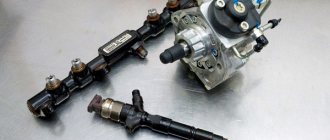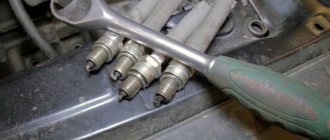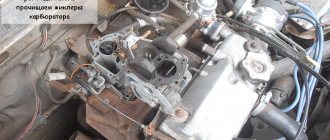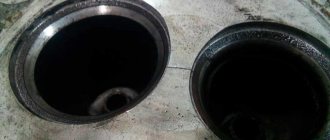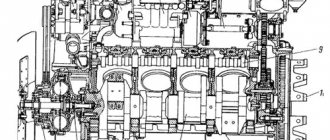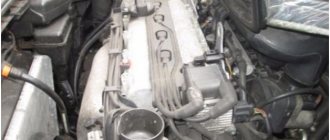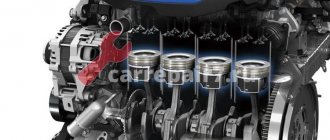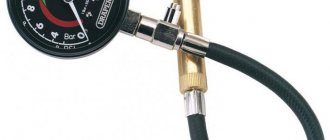The engine is shaking and the “check” is blinking: possible causes of the malfunction
As you know, the injection engine has replaced the carburetor engine mainly due to its efficiency, as well as the reduced amount of harmful emissions into the atmosphere.
This became possible as a result of flexible adjustment of the operation of the internal combustion engine using the electronic control system of the ECM. Note that the indicated “check” lights up for various reasons. In this article we will talk about why the check light blinks, the engine stalls, or the power unit is unstable in different modes, and such operation is accompanied by a lit internal combustion engine fault indicator.
Communities Lada Priora Lada Priora Club Blog Trouble check and blinking
So, we figured out the general scheme.
Now let's look at what problems lead to the check light coming on and the engine stalling. Often a p0300 error occurs, which indicates that a misfire (misfire) is occurring. There are several reasons for these omissions, and to determine them it is necessary to carry out a step-by-step diagnosis, taking into account certain individual symptoms. You should start by checking the ignition system. The most common cause of tripping is the failure of spark plugs and armored wires. Candles can wear out their service life, break down, or become heavily contaminated. Armored wires suffer from insulation damage and breakdowns. One way or another, the result is either no spark at all, or there is a spark, but it’s weak.
If everything is in order with the spark plugs and wires, you should pay attention to the ignition module or ignition coils, which may be shorting. In this case, it is better to entrust the check to experienced specialists, since unprofessional actions lead to the fact that you can burn the switch or damage other important elements
It should also be added that you need to carefully inspect the spark plug wells themselves. Quite often, the engine fails if water accumulates in the wells or engine oil gets there. In some cases, lubricant gets into the wells due to problems with the valve cover gasket.
Having dealt with the ignition system, it is necessary to check the power system. As a rule, incorrect operation of injection nozzles or malfunctions in their operation lead to engine tripping. At the same time, the check will light up or flash.
We also recommend reading the article about what misfires in engine cylinders are. In this article, you will learn about the causes of misfires and errors, as well as how to identify and fix the problem.
The best option would be to check the injectors on a special stand. Such diagnostics allows you to determine the need to clean, repair or replace injectors. At the same time, specialists check the power supply to the injectors, the condition of the injector O-rings, etc.
As for compression, a burnt-out valve often leads to an unexpected decrease in the indicator. If the valve burns out, the engine starts to run rough. In this case, tripling is constant and occurs in all modes of engine operation. Engine thrust drops significantly, and significant excess fuel consumption is observed.
Please note that in this case you cannot drive the car, as there is a high risk of damaging the catalyst and oxygen sensor (lybda probe). To confirm the diagnosis, you need to measure the compression, and to solve the problem itself, you need to remove the cylinder head, troubleshoot the head and change the valve.
Replace the oxygen sensor (lambda probe)
The oxygen sensor in your car is part of the exhaust system that monitors how much oxygen is not burned in the engine's combustion chamber. This sensor helps control the vehicle's fuel consumption. A malfunctioning oxygen sensor (lambda probe) means that the car computer is receiving incorrect data, which can significantly increase fuel consumption and reduce engine power. Most cars have 2 to 4 oxygen sensors. If you have a home car error scanner, then by connecting it to the car, you can easily find out which sensor needs to be replaced.
For what reason does the oxygen sensor in a car become unusable: Over time, the sensor becomes covered with a layer of used engine oil (oil soot), which reduces the accuracy of reading sensor readings for regulating the gasoline mixture and distributing optimal fuel consumption. A malfunction of the oxygen sensor in a car leads not only to increased fuel consumption, but also to an increased content of harmful CO2 substances in the exhaust.
What needs to be done: If you do not change a faulty car oxygen sensor, this can lead to failure of your car's catalyst (it may burst), which will result in expensive repairs. The cost of new catalysts is very high due to the precious alloys they contain. On some cars, there are several catalysts, the cost of which can reach up to 90,000 rubles. So don't delay replacing the sensor. Although replacing the sensor and its cost is not very small, it is not commensurate with the cost of the exhaust gas catalyst system. You can also save on replacement costs by doing it yourself. Many car manuals have detailed instructions on how to replace the oxygen sensor yourself. If you know where the oxygen sensor is located, then it will not be difficult for you to disconnect the faulty lambda probe and replace it with a new one. Remember that you cannot delay replacing this important element!
Check the fuel filler cap
Many drivers, in some cases, when the “check engine” indication appears, begin to think about serious problems with the engine; they do not even think of checking the tightness of the fuel system, which may be compromised due to a defect or an insufficiently tightened fuel tank cap. This is a very common reason for the appearance of the “Check” engine icon.
Reason for the error: - Leakage of the fuel system due to the passage of air through the filler cap of the fuel tank, as well as an increase in the fuel consumption of the vehicle, for which the vehicle’s diagnostic system will definitely display an engine error by turning on the “Check engine” indication on the vehicle’s instrument panel.
What needs to be done: -If when the “Check” indication appears, your car has not lost its power and there are no audible signs of engine damage (knocking, humming, creaking, etc. in the engine), then the first thing you need to do is check the gas tank for leaks. Your gas cap may be cracked or not tightened enough. If the gas tank cap was not tightened enough, then after tightening it all the way, you can continue driving the car for a while, and then look at the dashboard and see if the engine error disappears. To prevent the check engine light from appearing and lighting up, check the fuel filler cap regularly. Remember also that periodically this cover must be replaced with a new one!
Elimination methods
What do experienced mechanics do during diagnostics:
- Open the hood and connect the equipment to read the error due to which the check light is on.
- They find the error and use it to navigate where the problem area is.
- If it is a spark plug, then it is replaced, if it is wires, then they are soldered or also changed. High-voltage wires are removed from the engine compartment. Test them using a multimeter. Set the multimeter needle to resistance and check each wire with it.
- Check the pressure in the fuel system to determine the faulty cylinder.
- Change the air filter. Because it can also be the cause of tripling.
- Catalysts are changed.
Possible reasons for the check to light up
It doesn’t matter whether the injector has 8 valves or 16. The information in this section will help identify the problem on both types of engines. First of all, it’s worth figuring out what malfunctions are causing the light to light up. Sometimes you can identify a breakdown without even taking the car to a service center.
Broken spark plugs
A common problem, as spark plugs begin to not work as they should over time. There may be several reasons, but the most common ones are:
- Carbon deposits have accumulated, causing the spark to not be very good.
- The gap has changed due to burnt electrodes.
- Ceramic insulation is broken.
- Malfunction due to long-term use.
- Failure of high-voltage wires. The insulation on them may be broken, which disrupts the operation of the system.
To eliminate such problems, you need to change spark plugs and high-voltage wires.
The spark plugs must be unscrewed and inspected for carbon deposits. It is also necessary to check for the presence of a spark: it must be clear and strong enough. It is important that all candles spark approximately equally.
Throttle problems
This option is possible if the machine has been in use for a long time. The reason may be a malfunction of the mechanical part due to wear or carbon accumulation near the valve. Sometimes the opening and closing mechanism itself gets stuck.
The second reason, which is the most common, is failure of the throttle sensor. You can independently determine its malfunction, but it is quite difficult. It is much easier to take the car to a diagnostic shop, where they will check its performance.
Malfunction of the mass air flow sensor
The check engine on the VAZ 2110 very often lights up due to the failure of the mass air flow sensor. This option can even be called a disease of this model, so many people start checking with it. You can determine the problem yourself - gasoline consumption will increase very much.
If the check light is on and the car takes much more fuel than usual, you should immediately go to a car service center and have the mass air flow sensor diagnosed. This breakdown can be repaired quickly enough, and spare parts are inexpensive, so you shouldn’t drive with it and consume a huge amount of gasoline.
Use of low-quality fuel
If the check engine light comes on shortly after leaving the gas station, the cause is likely to be low-quality fuel. Because of it, the operation of the injection system is disrupted, detonation appears, and traction deteriorates significantly. The idle speed may also fluctuate, and failures during acceleration are often observed.
A loose or loose tank cap can also be a culprit.
The engine control unit receives information from sensors about improper operation of the system, and a light comes on on the panel. If this happens, it is better not to operate the car, but to drain the bad fuel and fill it with normal fuel. If the problem occurs on the road, you can drain most of it and add good gasoline. This also helps.
Sometimes you come across fuel of such poor quality that you have to flush not only the tank, but the entire system. If this is not done, the injector may fail, and repairs will cost many times more.
Low oil pressure in the system
This option is also often the cause of the problem. There may be several reasons:
- Failure to comply with oil change schedules. Over time, the lubricant loses its properties, becomes liquid and becomes heavily contaminated. This prevents the pump from creating the required pressure in the system.
- Poor quality oil. This is not difficult to determine, because the light will light up shortly after replacing the lubricant.
- The oil pump is broken or is not working properly. Circulation is disrupted or stops altogether, which is very dangerous. If you drive with such a malfunction, the engine will fail due to overheating.
The channels through which lubricant flows may also become clogged. Most often, the reason for this is untimely oil changes, so you should not ignore the established periods.
You should first check the oil level in the pan. The reason may be a leak.
Problems with the ignition coils
Another option for why the check light is on is a malfunction of the ignition coils. They don't necessarily fail, but if there are any problems, it will inevitably lead to errors. It is necessary to check all connections to high-voltage wires, as they may be damaged.
Then test the coils. It’s easy to do this even with your own hands. If diagnostics reveal a problem, it is best to replace the coils as a set. There are 4 of them in the VAZ 2110, the price is low, so repairs will not be too expensive. You can change them yourself in a few minutes.
Burnt out catalyst
Another common reason for a signal to appear on the control panel. If this part of the exhaust system is burnt out, it can be easily determined by the loud exhaust sound and the smell that comes not from the pipe at the back, but from below. Sometimes there may be a connection problem.
Why does the check light on VAZ 2110 light up?
The engines installed on the VAZ 2110 are electronically controlled and have numerous sensors, information from which is processed by the engine control unit. If there is any problem, the Check Engine light comes on on the dashboard. The presence of such a warning indicates serious engine problems, so it is necessary to take the car to a service center as soon as possible and carry out appropriate diagnostics and troubleshooting. In this article we will tell you why the check light comes on on 8 and 16 valve VAZ 2110 engines.
Broken spark plugs
If the check engine light comes on on the dashboard of your VAZ 2110, first of all you need to pay attention to the condition of the spark plugs and high-voltage wires. Over time, the spark plug gap changes, resulting in a lack of spark in the cylinders, and the corresponding sensors determine whether there is a problem. That is why, as soon as such an alarm lights up, it is necessary to check the spark plugs for the presence of a spark. The car owner should also inspect the condition of high-voltage wires, which may have mechanical damage, which leads to improper operation of the power unit in the VAZ 2110. Remember that the spark plugs must be changed regularly, which will help avoid such problems with the car engine.
Throttle problems
The sensor located on the throttle valve can cause problems. Unfortunately, it is not possible to independently diagnose in this case. The car must be towed to a service center, where, using special equipment, specialists can identify errors with the throttle valve or identify other problems with the engine that may cause the Check Engine light to come on.
Damage to the mass air flow sensor
The faulty engine warning light may also come on if there are problems with the air flow meter. Such a sensor (mass air flow sensor) often fails or starts to work incorrectly, which leads to problems with the motor. Problems with the mass air flow sensor in the VAZ 2110 engine can be indirectly determined by significantly increasing fuel consumption. Note that it is not recommended to operate an engine with such breakdowns, so if the Check Engine light comes on and fuel consumption increases, it is best to go to a service center and carry out high-quality computer diagnostics. The cost of spare parts and repair work in this case is not too high, which will allow you to fully restore the functionality of your car.
Refueling with low-quality fuel
The Check Engine light may come on immediately after refueling with low-quality fuel. Such dirty and low-quality fuel, entering the engine, invariably causes increased detonation and improper operation of the injection system, and as a result, the engine control unit receives errors from the built-in sensors and a check light on the dashboard lights up. If such an alarm lights up immediately or shortly after refueling, it is most likely due to low-quality fuel. It is not recommended to operate the car in this case. You need to call a tow truck and take the car to a service center, where specialists will comprehensively diagnose the car and clean the fuel system. Otherwise, the injector may be damaged, which will lead to expensive engine repairs.
Insufficient oil pressure in the system
The Check Engine light may come on if there are problems with the lubrication system. For example, if there is insufficient oil pressure or in cases of breakdown of the oil pump, which does not pump lubricant, the engine temperature invariably increases and a corresponding warning lights up on the dashboard. At the same time, the low oil pressure light may come on.
Problems with the ignition coils
High voltage ignition coils and problems with these components can also cause a warning to appear on the instrument panel. Such problems can be indirectly determined by the characteristic tremors of the car at idle. The car owner can check whether there is current on the coil and whether the contacts of the high-voltage wires are loose. If there are problems with the coils, it is best to replace them as a set. The VAZ 2110 engine has four high-voltage coils, the cost of which is at an affordable level, and every car owner can handle such a replacement.
Lambda probe failure
On 16-valve modifications of the VAZ 2110 engine, a lambda probe is installed, which is responsible for analyzing exhaust gases. Over time, a layer of used oil appears on the surface of such a lambda probe, which leads to problems with the accuracy of the sensor’s readings. As a result, the Check Engine light comes on, and the car must be taken to a service center. It is impossible to independently determine the problem with the lambda probe. Only when diagnosing a car using special equipment can you determine the corresponding error codes, on the basis of which problems with the lambda probe will be identified. This element cannot be repaired and if it breaks, it is simply replaced with a new one.
Burnt out catalyst
Problems with the catalytic converter can also cause a Check Engine Light. Such problems can be indirectly identified due to the appearance of an uncharacteristic exhaust sound, while the engine begins to smoke heavily. It is necessary to check the catalyst at a service station and if problems with this unit are identified, it must be replaced with a new one or cut out. It is not recommended to use a car with a damaged catalyst, as this can lead to various types of serious damage, including the need to overhaul the power unit.
Reasons for the appearance and blinking of the “check” on the VAZ-2112
If we consider engines with a volume of 1.5 liters, we can talk about one of two internal combustion engines: VAZ-2111 (8v) or 21120 (16v). In the first case, the ignition module 2111-3705010 is used, in the second - 2112-3705010. These modules are not capricious and do not often require repairs. We have already written about diagnosing the ignition module and repairing it.
Ignition system of the “tenth” family
The modules themselves, as you can see, are different, but they have the same “disease”. It is not the module that is to blame here, but its high-voltage connectors. The terminal may move away from any of the four connectors, but nothing will change externally. And after a while the terminal on the cable will burn out. Then the engine will begin to “trouble” and misfires will be noticed by the controller. Therefore, constant checking of the ignition module is necessary.
Let's clarify: at first the terminal comes off, but the current is carried out. Then charring occurs. On the dashboard of any car, including the VAZ-2112, the check will not light up immediately. And as soon as it lights up, check the contacts!
Two cases from practice
This is what happens in reality. The owners write:
- For some reason, the check light starts flashing when the speed exceeds 100 km/h;
- The lamp blinked only after warming up to 100 degrees;
- Etc.
There are many cases, but the reason is one. Contact can be disrupted by vibration, although in the first case they talk about speed. Well, thermal expansion also cannot be discounted.
What exactly needs to be done
Check the cap on each of the wires: if the copper is burnt, clean it with ASIDOL, ammonia and ordinary chalk. The taps on the module should also be cleaned. For better protection, you can apply lithium grease (Litol-24).
Litol will help us
Here's what you can't do:
- Check for the presence of a spark by bringing a “grounded conductor” to the tap;
- Connect the “+” terminal removed from the battery to ground with the engine running;
- Apply voltage “+12” to any of the module contacts.
How to perform an express check: the key is at “0”, then we measure the resistance between taps 2-3, 1-4. Both values must match. By the way, the multimeter must be a dial gauge.
Precautions: When connecting the multimeter to the module, do not touch two probes with your hands at the same time. The measurement limit is 100 kOhm or 10 kOhm.
How to distinguish “gaps” from everything else
Let's consider the situation: it is difficult to start when hot. If it starts when cold, the check light then turns on, but after 20-30 minutes it goes out. In this case, we can conclude that there is a misfire. Well, they can even be caused by an insulation breakdown. And above we looked at what is typical for the 2112 family (but not for the 21124 engine).
This block is too smart
They may say that the check for the VAZ-2112 caught fire for no reason. This happens in cases where:
- The indicator turns on, then the engine is turned off and the battery is disconnected (disconnect the minus terminal for 10 minutes);
- After connecting the battery, no defects are observed. Start the engine - the check lamp does not light up.
In fact, the ECU actually remembers any defect (the occurrence of any error). But the “reset” is also performed by the system itself:
- When starting the engine;
- After the next test cycle.
For each error, one of two methods is used. And, in theory, there is no point in disconnecting the battery. If the “check” is constantly on, then you need to look for a defect. And “terminal tricks” usually don’t help.
Why the check light on the VAZ-2112 16 valves lights up and flashes: the main reasons
Car : VAZ-2112. Asks : Alexander Glukhovsky. The essence of the question : the VAZ-2112 check light comes on and is blinking, what should I do?
On my hatchback with a fuel-injected engine, the check light started flashing. Once the effect went away on its own, then it appeared again. By the way, my engine is 1.5 liters. I heard that on a VAZ-2112 the check light can light up just like that, but in my case the light is blinking! The sound of the engine also changes. So there is a reason. Help me find her!
High voltage wires
What should you do if, after replacing the spark plug, the “check” flashes and the engine starts again? In such a situation, it can be assumed that the reason lies in the high-voltage wire. It can be checked in two ways:
- Visually. We take out our wire and look at its integrity. The high-voltage element must not contain cracks, cuts or abrasions. Any of these symptoms can provoke a breakdown of the wire, due to which the coil will not be able to transmit a spark even to a known-good spark plug. You can also check the wire in another way. In the dark you need to watch its work. If “crickets” are visible, this indicates that there is a severe breakdown of the insulation.
- Using a multimeter. This is a more accurate way of diagnosis. To measure the resistance of a high-voltage wire, the multimeter is switched to ohmmeter mode. Then, using probes, you need to touch both sides of the wire. Next, the device will display information. The resistance of high-voltage wires should be no more than 10 kOhm. If the indicator is higher than normal, this indicates the presence of a breakdown.
Ideally, high-voltage wires should be replaced as a set.
What does the Check Engine icon mean on a VAZ 2114
When the check light comes on after turning off the ignition of a VAZ 2114, you need to check the engine. It is important to take into account that the problem often lies not in the engine itself, but, for example, in the ignition and fuel supply systems. Minor malfunctions such as breakdowns of the catalyst or a gas tank cap that is not screwed on completely are also possible. The signals cannot be ignored, as the breakdown will become more serious over time.
The indicator can be found on the instrument panel under the engine speed indicator. To designate it, a rectangle with the appropriate inscription is used (check or engine check), there is a schematic sign, a lightning bolt.
The check signal does not always indicate serious malfunctions
How to distinguish “gaps” from everything else
Let's consider the situation: it is difficult to start when hot. If it starts when cold, the check light then turns on, but after 20-30 minutes it goes out. In this case, we can conclude that there is a misfire. Well, they can even be caused by an insulation breakdown. And above we looked at what is typical for the 2112 family (but not for the 21124 engine).
This block is too smart. They can say that the check for the VAZ-2112 caught fire for no reason. This happens in cases where:
- The indicator turns on, then the engine is turned off and the battery is disconnected (disconnect the minus terminal for 10 minutes);
- After connecting the battery, no defects are observed. Start the engine - the check lamp does not light up.
In fact, the ECU actually remembers any defect (the occurrence of any error). But the “reset” is also performed by the system itself:
- When starting the engine;
- After the next test cycle.
For each error, one of two methods is used. And, in theory, there is no point in disconnecting the battery. If the “check” is constantly on, then you need to look for a defect. And “terminal tricks” usually don’t help.
What can cause tripping?
The causes of the described malfunction can be very different.
To reliably install them, you must first find the faulty cylinder. It is recommended to start such a search from the very moment when it was discovered that the check engine light was on. At least, such recommendations are given by the manufacturer who installed an automatic fault warning system on the car.
The search procedure is quite simple. To do this, it is quite enough to disconnect the power tips from the spark plugs
.
As a result of this alternate shutdown, it is possible to determine the inoperative cylinder by the sound of the engine
. If the sound of the engine has changed, this means that the culprit of the “triple” has been detected.
If the check light on Kalina is on and computer diagnostics of the engine is carried out, the faulty cylinder will be indicated by the computer. At the same time, this diagnostic method can also help to establish the initial causes that led to its malfunction. They could be the following:
- incorrectly set ignition timing;
- presence of air leaks in the vacuum brake booster;
- defective spark plugs;
- breakdown of electrical wiring and capacitor wires;
- presence of air in the exhaust manifold;
- wear or breakage of piston rings;
- burnout of pistons and valves;
- incorrect valve timing;
- cylinder head defects;
- severe wear of the valve stem seals;
- poor carburetor adjustment;
- air filter contamination;
- use of spark plugs incompatible with this engine.
In this case, the main malfunction leading to the fact that one of the cylinders becomes inoperable is considered to be the failure of the spark plugs
. A sign of this may be the fact that Kalina’s engine does not warm up well, especially in the morning.
In addition, it is always worth making sure that when operating a car, only those spark plugs that are recommended by the manufacturer are used. This can extend the life of the engine for a very long time.
Prevention of car engine tripping
Prevention of such a phenomenon as engine “triplication” is that the car owner needs to promptly eliminate the most common malfunctions of the engine, as well as other related systems. To do this, it is necessary to strictly adhere to the periodic maintenance schedules established by the manufacturer for the vehicle. At the same time, if you have little experience in owning a car, it is better not to engage in serious technical work yourself, but to entrust their implementation to experienced specialists.
In addition, it makes sense not to delay carrying out prevention at the first deterioration in engine performance, attributing them, for example, to low-quality gasoline. At the same time, all preventive measures should be carried out only in those auto repair shops where experienced craftsmen work. For example, incorrectly set ignition timing can lead to the appearance of “triple”. Unqualified service station employees very often sin with this, especially if the car owner is a novice behind the wheel and has little understanding of the technical side of the matter.
In the same case, when all systems and components of Kalina work correctly, the “triple” effect should not occur. In this case, the service life of the engine should be significantly reduced, since the power unit, in which one of the cylinders is inoperative, may experience increased loads, leading to its accelerated failure.
It is worth mentioning the Traffic Rules, which directly prohibit the operation of a vehicle with a faulty engine. Therefore, it is better not to risk either money or rights, and if a “triple” effect occurs, immediately send the car for repairs.
